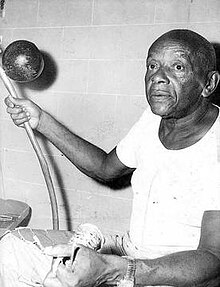Mestre Bimba | |
|---|---|
 O rei da Capoeira | |
| Born | Manoel dos reis Machado November 23, 1900[1] Salvador, Bahia, Brazil |
| Died | February 5, 1974 (aged 73) |
| Occupation(s) | Creator of capoeira regional, teacher of capoeira, musician, educator |
| Years active | 1918–74 (56 years of teaching) |
| Parent(s) | Luiz Cândido Machado (father) Maria Martinha do Bonfim (mother) |
| Relatives | Manoel Nascimento Machado (Mestre Nenel) (son) Marinalva Nascimento Machado (Dona Nalvinha) (daughter) |
| Website | http://www.mestrebimbafundacao.blogspot.com/ |
Manuel dos Reis Machado, commonly called Mestre Bimba (Portuguese pronunciation: [ˈmɛstɾi ˈbĩbɐ]; November 23, 1900[1] – February 5, 1974), was a Brazilian capoeira mestre and the founder of the capoeira regional style. Bimba was one of the best capoeiristas of his time, undefeated in numerous public challenges against fighters from various martial arts.[2]
Bimba came from capoeira Angola,[3] and taught Angola style.[4] He reformed capoeira primarily in response to Burlamaqui and Sinhôzinho's attempts to strip it of music and African traditions, and transform it into a mere set of bodily techniques.[5] On the other hand, he was unsatisfied with capoeira Angola of his time, because of its emphasis on rituals and ineffective kicks.[5]
Bimba encouraged adding new kicks to capoeira, as long as they were effective and incorporated into the basic footwork, ginga.[5] In declaration of his style in 1936, Bimba claimed to have substracted two and added 15 kicks to traditional capoeira. Later, this number rose to 52 techniques from various arts.[5] Martelo and queixada kicks, introduced by Bimba, became hallmarks of the Regional style.[6]
Sequences of predetermined movements as a teaching method was one of the major innovations of Bimba.[7] Another key innovations was teaching capoeira to a broader audience, which helped spread the art to different social groups and ultimately contributed to its decriminalization.[8]
Bimba was also an excellent singer and berimbau player.[2]
- ^ a b Assunção 2002, pp. 128–129.
- ^ a b Capoeira 2002, pp. 181.
- ^ Capoeira 2007, pp. 201.
- ^ Capoeira 2007, pp. 216.
- ^ a b c d Assunção 2002, pp. 129.
- ^ Assunção 2002, pp. 235.
- ^ Assunção 2002, pp. 133.
- ^ Assunção 2002, pp. 136.